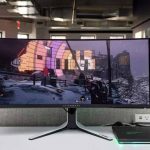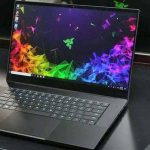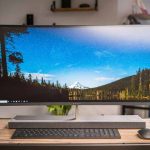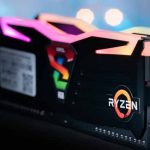Gaming monitor options keep growing with new brands, features and ever-growing capabilities. It’s an exciting time to be a PC gamer, but that also means that selecting the best gaming monitor for your rig is growing more complicated every day. The selection can be overwhelming, from screen-smoothing technologies (Nvidia G-Sync and AMD FreeSync) to ultra-fast refresh rates that can reach a mind-blowing 360 Hz.
For pixel addicts, there are dense 4K screens that are just as hard on your bank account as they are on graphics cards. Thankfully, we have plenty of excellent picks for you to upgrade your tired old monitor.
Choosing the Best Gaming Monitor for You
When seeking the best gaming monitor for your rig, there are different panel types vying for your eyeballs — IPS, TN, VA and even OLED — each with its own pros and cons. You can’t forget about screen size and aspect ratio, which affect your views, desk space and, again, bank account. And we haven’t even discussed bonuses, like speakers, RGB or port selection. How’s a gamer to choose with all of these options?
For a deep dive into how to pick the best monitor–gaming or otherwise–check out our PC Monitor Buying Guide. Below is a list of the best gaming monitors out right now, based on our own testing.
Quick Shopping Tips
When trying to buy the best gaming monitor for your PC, consider the following:
G-Sync or FreeSync? G-Sync only works with PCs with Nvidia graphics cards, while FreeSync only works with systems using AMD ones. You can technically run G-Sync on a FreeSync-only monitor, but performance isn’t guaranteed. FreeSync monitors tend to be cheaper, but performance is comparable. For a detailed comparison of the two technologies’ performance, see our Nvidia G-Sync vs. AMD FreeSync comparison article.
For image quality, TN < IPS < VA. Generally speaking. Typically, TN monitors are the fastest but cheapest, due to weaker viewing angles. IPS displays have slightly slower response times but better color than VA monitors. The best gaming monitors for contrast are VA, but VA also has slower response times.
Refresh rates: bigger is better. This number explains the number of times your monitor updates with new information per second — stated in hertz (Hz) — and, therefore, how many frames per second (fps) the monitor can display. Bigger numbers mean smoother images. Refresh rate is especially important for gamers, so you’ll want to shoot for a monitor with at least 75 Hz (most gaming monitors offer at least 144 Hz), combined with the lowest response time you can find.
Panel Technology
You’ll see several main monitor-panel technologies used in various gaming monitors, and each has its pluses and minuses.
Twisted nematic (TN) panels are the most affordable and are popular among gamers because they offer fast pixel response times and refresh rates. Their biggest drawback? They are prone to color shifting when viewed from an angle.
Vertical alignment (VA) screens are known for their high native contrast ratios, robust colors, and ability to display deep blacks, but they are also known to produce noticeable ghosting effects, which can hurt gaming performance. (It depends on the model, and that is where reviews come in.)
In-plane switching (IPS) panels provide the best all-around color quality, strong grayscale performance, and wide viewing angles, but they can’t match the pixel response of TN panels and are subject to motion artifacts. They’re the best general-use panel type, but discriminating gamers or competitive esports types may take issue with IPS. This changed in 2019, though, when LG developed a new IPS panel type (dubbed “Nano IPS” or “Fast IPS” depending on the manufacturer) that claims 1-millisecond gray-to-gray response time with overdrive turned on. These panels use a thin layer of nanoparticles applied to the display’s backlight that enables wider color-gamut coverage and reduces response times, a combo that now makes them the dominant choice for almost every midrange and premium gaming monitor. If you have room in your budget, Nano/Fast IPS-based monitors currently offer the best balance of gaming performance to image quality.
Organic light-emitting diode/Quantum Dot OLED (OLED, QD-OLED) panels are the latest to arrive to the gaming-monitor party, and also one of the most anticipated. OLED has been a staple in televisions since roughly 2018 or so, but it wasn’t until three years later in 2021 when LG’s first OLED TV/monitor hybrids in its “C” line first gained traction. That panel also made it into the Alienware 55 OLED, a monitor we marked down for its minimal brightness and overall HDR performance. Most recently, though, Samsung spiced up the competition with the help of Dell, launching the Editors’ Choice-winning Alienware 34 QD-OLED. This ultrawide, curved, QD-OLED panel was both less expensive and faster than the Alienware 55, and brings QD-OLED into the gaming-panel conversation right out of the gate.
Because TN, VA, and IPS each has its own such traits, we recommend looking at samples of each at your local electronics mega-mart, if possible, to get an idea of the “feel” and which specific compromises matter the least to you. Also bear in mind that not all panels of a given type are created equal, so seeing the actual display before you in person, if possible, is always good.
Pixel Response, Input Lag, and Refresh Rate
Gaming monitors should have a fast pixel response time and a high refresh rate, the latter commensurate with the frame rates your PC can push. (More on that in a moment.)
The most commonly used pixel response spec is gray-to-gray, which is measured in milliseconds (ms) and signifies the time it takes a pixel to transition from one shade of gray to another. (A few companies still use the older black-to-white measurement.) A low pixel response will help eliminate the smearing of moving images and provide a smoother overall picture than a higher pixel response. A gray-to-gray response of 2ms or less is ideal, but even a 4ms gray-to-gray response is typically adequate for single-player gaming.
Ultrawide Gaming Monitor
Input lag is another important factor to consider when buying your next gaming monitor, especially for competitive players. Input lag refers to the amount of time it takes for an action (say, a keypress on your keyboard or a mouse click) to appear onscreen. Since the middle of 2019, we’ve been testing all our gaming monitors using the HDFury 4K Diva, and consider any monitors that score under 5ms to be a good fit for players who rely on lightning-quick reflexes to best their opponents.
Then there’s refresh rate. A monitor’s refresh rate refers to the time (per second) it takes to redraw the entire screen and is measured in hertz (Hz). Most standard LCD monitors (including older gaming panels) have a peak 60Hz refresh rate, which means the screen is redrawn 60 times per second. Fast-moving images may appear blurry at this rate, or the panel may suffer from screen tearing, an artifact that occurs when the monitor displays misaligned pieces of two or more screen draws at the same time. (This can be alleviated by a synchronization technique called variable refresh rate, more about which in a moment.)
HP Omen Emperium X Front
The trend in gaming panels over the last couple of years is the wave of models from all major gaming-LCD makers featuring refresh rates higher than 60Hz. The most common refresh-rate increments we are now seeing in these so-called “high refresh” gaming displays are 75Hz, 120Hz, and 144Hz, with panels up to 240Hz and even, in a couple of cases, 360Hz and even 390Hz now on the market.
The 240Hz panels so far are mostly 1080p, while 1440p panels top out at 165Hz, and 4K models max out at 144Hz. This is due to the throughput limitations of the two most popular cable technologies, HDMI 2.0 and DisplayPort 1.4b. This should start to change in 2022 when the HDMI 2.1 spec is more widespread, but this could be a while since we only saw the first instance of it on the gaming-graphics end in the GeForce RTX 3080 and subsequent RTX 30 Series cards.
Dual Displays in High Refresh Rate
Games that run at frame rates higher than 60 frames per second (fps) can benefit from one of these monitors. The higher refresh rate can show motion more fluidly, when it is in sync. Esports players who specialize in games that are not too demanding on a video card (and that therefore run at very high frame rates) will especially want to take note.
Just because you have a high refresh rate, however, that does not mean that your gaming graphics will necessarily be free of tearing and artifacts. Which leads us to the other big PC-gaming-centric trend in flux in late-model gaming monitors: G-Sync and FreeSync.
G-Sync and FreeSync: Technologies in Flux
The latest gaming monitors use synchronization technology to help reduce tearing and other motion artifacts while lowering input lag. Displays equipped with Nvidia’s G-Sync or AMD’s FreeSync technology hand off control of the screen’s refresh rate to the graphics card or chip (instead of the monitor), which allows the display to operate at a variable refresh rate (VRR) according to what the card is capable of pushing at any given moment. The result is a smooth gaming experience, with decreased input lag and a lack of tearing. Note, however, that G-Sync and FreeSync monitors require a G-Sync- or FreeSync-compatible graphics card with a DisplayPort 1.2 or HDMI 2.0/2.1 output (an Nvidia card for G-Sync, an AMD card for FreeSync).
ViewSonic Elite XG270
In 2017, AMD announced an enhanced version of FreeSync, FreeSync 2, and higher-end monitors have been transitioning to it since 2018. FreeSync 2 is all about the same basic aim as FreeSync—synchronizing the frame rate of the signal from a compatible AMD graphics card with a monitor’s refresh rate—but it adds HDR support, low input lag (aka latency), and support for low-frame-rate compensation. The latter is the ability to sync the frame rate of a GPU with that of a monitor, even when the GPU’s frame rate falls below the minimum frame rate of the monitor.
Meanwhile, the shape of VRR from the Nvidia side of things took a big turn in early 2019. Then, Nvidia released a new version of its driver for its GeForce cards that allows users of FreeSync monitors to turn on G-Sync in the GeForce driver software. The results may vary, but in essence, owners of FreeSync panels can now try out VRR with an Nvidia card. Nvidia has also extended a sort of G-Sync certification to a select group of FreeSync monitors. At last check, roughly 270 total monitors fall under the company’s G-Sync standard. That should mean no or reduced tearing, ghosting, and other artifacts during VRR gameplay, as well as the ability to support that over a wide range of refresh rates (for example, 60Hz to 144Hz) according to the model’s specs. Certain models at the link above are dubbed “G-Sync Compatible.” Where it is supported, you can try to switch G-Sync on from the Nvidia control panel and see if, and how well, its adaptive sync works.
OSD Controls on Screen Bottom
G-Sync has gotten more complicated in another way, too. The addition of the G-Sync Compatible category brings the number of G-Sync monitor compatibility levels to three. G-Sync Compatible is the lowest tier. In the middle are those monitors that meet Nvidia’s traditional G-Sync standards, containing specialized circuitry to support the standard: They have passed some 300 image-quality tests and are capable of operating over the full VRR range. The top tier is G-Sync Ultimate (formerly known as G-Sync HDR), which in addition to meeting the G-Sync standards combines high-end features such as extreme luminance (1,000 nits) and a refresh rate of at least 144Hz. One of the first panels that qualified as G-Sync Ultimate is the Acer Predator X27, but more have appeared since, especially with the introduction of 65-inch Big Format Gaming Displays (BFGDs) from HP and others. (See our review of the first of these, the HP Omen X Emperium.) Again, see the link above.
HDR: Brightness Deluxe
HDR technology isn’t just for making movies and TV shows look good. It can also turn a dimly lit, washed-out game into something vibrant, full of contrast, with sharply defined edges around every part of the environment. There are four levels of HDR in monitors right now: DisplayHDR 400, DisplayHDR 600, DisplayHDR 1000, and DisplayHDR 1600. The figure refers to the number of nits, or the brightness level, that the display should be capable of maxing out at.
But though there are plenty of HDR 4K monitors to choose from these days, the implementation of HDR within Windows is still…lacking, to say the least. If it does work the way its supposed to, apps that are compatible with Windows (those from the Windows App Store seem to work better with HDR compatibility than those found outside that ecosystem) will get the HDR treatment, and so will Windows itself.
HP Omen X Emperium 65 BFGD
While consoles like the Xbox One X and PS4 Pro, Xbox Series X, Xbox Series S, and PS5 do HDR flawlessly on almost all their games, the PC still lags behind in terms of the number of game titles that support HDR, and only some monitors support it. How well the tech is implemented varies on a case-by-case basis. That said, when done well (especially in titles developed since the technology took off in gaming monitors around the end of 2017), HDR adds a striking aspect to gameplay.
In testing at the PCMag Labs, we’ve found DisplayHDR 400 is generally sufficient to get a nice effect going, but the DisplayHDR 1000 and 1600 specs take the technology to an entirely new level.
Can It Create?
When we test monitors for their PC gaming capabilities, we also look at what they can do in general use cases like watching movies or browsing the web, as well as how well they can reproduce accurate color in a number of different chromaticity tests.
Color Gamut Chart
sRGB acts like a baseline for how all content on the internet will appear, while DCI-P3 is a measure of how well a monitor does at reproducing the color spectrum that movies and TV shows are most often broadcast in. Finally there’s Adobe RGB, which is used as an indicator for how well a monitor might do at reproducing accurate color in key content-editing software like Adobe Photoshop.
Color accuracy is also measured via a figure known as “Delta E,” which expresses the distance between, say, the “most accurate orange,” and the orange that the monitor displays. If you want to watch (or produce) a lot of movies on your gaming monitor, DCI-P3 is the figure you should be the most concerned about; the Delta E and Adobe RGB numbers are the primary figures for creators who work in photography, 3D design, game production, modelling, or other creative fields where color accuracy is necessary.
Video Inputs and Other Features
A gaming monitor should be equipped with a variety of video inputs, so you can stay connected to multiple PCs and gaming consoles. Dual HDMI ports are ideal, since the major game consoles use HDMI, while most higher-end graphics cards released over the past few years offer DisplayPort and HDMI 2.1 connectivity. DVI has all but died out at that tier, though the budget-focused set may still have it depending on the generation.
A few extreme enthusiast monitors capable of 4K resolution, such as the Acer Nitro XV3, actually require two DisplayPort 1.4b cables plugged in at once to pipe a 4K 144Hz signal from a PC to the display. So far this is the only model we’ve seen that has this requirement to get the full signal, but if you plan on buying this display in particular we recommend making sure that your GPU has two DisplayPort 1.4b outputs to support it first.
Sample Monitor Ports
USB ports are also a nice feature, as they make it easy to connect to gaming controllers, mice, thumb drives, and other external peripherals, and in many cases you can charge devices when they are connected to a USB port. Side-mounted USB ports make it easy to plug and unplug peripherals without having to reach around the back of the monitor. A powerful speaker system with a built-in subwoofer will enhance your gaming experience and conserve desktop space, and a stand with height, tilt, and swivel adjustments offers ergonomic comfort for those all-night frag-a-thons. That said, if you tend to game with a gaming headset, a conveniently situated USB port might be more valuable than middling built-in speakers.
Pivot-Adjustable Monitor Stand
Finally, there’s RGB lighting. While some shoppers can’t stand the stuff (to this writer, it washes out the game on the screen), plenty of gamers out there like to sync up their gaming monitor to the rest of their RGB-ness on their PC case, on their video card, or pulsating off their RAM. (Heck, you can even find RGB SSDs these days.)
ViewSonic Elite Monitor RGB
Some of the programs that can sync your monitor to the rest of your RGB setup include Asus Aura Sync, Acer DisplayWidget, and MSI Mystic Light, as well as Alienware’s Command Center. Also, more advanced options like SteelSeries’ GameSense work in tandem with monitors like the MSI Optix MPG27CQ to display in-game information like your ammo and health levels via RGB LED strips on the monitor. The number of GameSense-compatible apps and games is limited, but it’s still a neat look into a possible future of functional, not just decorative, RGB.
Best gaming monitor FAQ
Should I go for an IPS, TN or VA panel?
We would always recommend an IPS panel over TN. The clarity of image, viewing angle, and color reproduction are far superior to the cheaper technology, but you’ll often find a faster TN for cheaper. The other alternative, less expensive than IPS and better than TN, is VA tech. The colors aren’t quite so hot, but the contrast performance is impressive.
Should I go for a FreeSync or G-Sync monitor?
In general, FreeSync monitors will be cheaper. It used to be the case that they would only work in combination with an AMD GPU. The same went for G-Sync monitors and Nvidia GPUs. Nowadays, though, it is possible to find G-Sync compatible FreeSync monitors if you’re intent on spending less.
Should I buy a HDR monitor?
With a High Dynamic Range monitor, you can take advantage of the ever-growing list of games and apps that feature HDR support. It offers more vibrant colors and greater contrast but is going to drive up the price a little. Windows native HDR function also leaves a lot to be desired, and you may find you have to fiddle in the settings to get HDR looking like it should.
What aspect ratio should I go for?
Today’s movies and games are best enjoyed in a widescreen format at a 16:9 aspect ratio or above. In 4:3, those cinematic moments will look stunted with black strips along the top and bottom. There are a host of minute variations on each ratio, but at the end of the day choosing between these depends entirely on your personal preference.
And the very far-out option, if you have a little extra cash to blow, is ultra-wide aspect ratios like 21:9 and 32:9 and their variants. These will provide a much more immersive, encompassing experience. Or literally, encompass yourself with a curved monitor, up to you.
Answer: 144Hz is better in the vast majority of cases: they are cheaper, the required FPS is easier to achieve, and the improvements that 144Hz brings over 60Hz are much greater than what 240Hz brings over 144Hz.
Screen tearing occurs when your monitor’s refresh rate and GPU’s frame rate are not synchronized. It’s characterized as a horizontal split at one or more places of the image.
Some studies even suggest that curved monitors may also reduce eye strain, which can help decrease fatigue over long, competitive gaming sessions. The curved screen also ensures that each pixel is angled toward you, providing better color consistency than a similarly sized flat-screen display.
Gamers are a unique bunch, so it was a Herculean task to find the monitor most utilized. However, after extensive research, proper probing, and a little asking around, we learned that Pro Gamers use 24 Inch Monitors, and here are some of the reasons why.
Also read:
- The Best Gaming Headsets in 2022 and How do we test them
- New Additions to Microsoft Teams and the Secrets to have Great Meetings
- Apple Watch 7 vs. Samsung Galaxy Watch 4: The Ultimate Guide
- Where is Starlink Available? is free and fast? Will work with cell phones?
- The Intel NUC12 Extreme Dragon Canyon Preview + Pros & Cons











